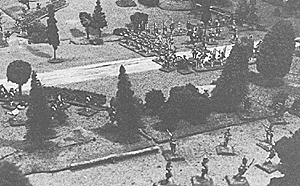 Braddock's Advance Guard has formed and is under attack from three sides. Miniatures are 30mm Willies and Staddens plus 25mm Hinchliffe and RSMs from the collection of Bill Protz. Photo by Bill Kojis.
Braddock's Advance Guard has formed and is under attack from three sides. Miniatures are 30mm Willies and Staddens plus 25mm Hinchliffe and RSMs from the collection of Bill Protz. Photo by Bill Kojis.
From Bill Protz, jr:
One of the most misunderstood battles of The French and Indian War, 1754-1760 was the Battle of the Monongahela. Fought between the British and French, it is often referred to as Braddock's Defeat. While hacking its way through the forest to capture French Fort Duquesne (now Pittsburgh, Pennsylvania, USA), a brigadesized force of British regulars and American provincials led by Major General Braddock suffered ignominius defeat in a legendary battle of homeric significance.
Many believe the British were ambushed. This is untrue. Braddock's force was adequately protected by flankers and advanced pickets. It was a tough battle which resulted in a resounding victory for the French with tremendous negative repercussions for the British/American colonies. However, it was also a starting point for the British to learn adaptations to new conditions of warfare which they had not encountered before. This in part led to victory in 1760.
The battle can be played as an entertaining wargame. The Kopperman book mentioned in the bibliography will assist in this regard and is the best source to learn what happened and in designing your own scenario. Also take another look at the cover artwork of this issue to see E.W. Deming's impression of Braddock's Defeat when the general receives his mortal wound, courtesy of the State Historical Society of Wisconsin. Now please enjoy Captain Dave Parker's monograph.
DEDICATION
I wish to dedicate this article to K. Jack Bauer, my mentor in military history. He regretfully passed away in September 1987. We were close and he was very influential in my life.
FIRST MOMENTS OF BATTLE UPON THE MARCH TO FORT DUQUESNE
The young officer shot bolt upright on his charger and with eyes and ears straining tried to take in the scene that confronted him. A rattle of musketry was followed by the sound of hoofbeats clattering down the trail. Men emerging from the trees were mounted scouts returning pell-mell from their post a few hundred yards ahead of the advance guard. They reined in and shouted, "The enemy, we've run into the enemy!" Young Lieutenant Colonel Thomas Gage, commander of Major General Edward Braddock's advance guard, must have been momentarily dumb-struck, and wondered, "How could the French be here? Surely they wouldn't set their ambuscade here, when they had already failed to do so at the two river crossings! Hadn't we already passed the best places for attack? Shouldn't the French be waiting, holed up in their fort, or even more sensibly, be streaming back north to safety?" [1]
Instead, it was the van's small advance party of Indians and scouts who were streaming back to safety. They had been shaken by the unexpected appearance of so many Frenchmen. While their startled foes halted, confused, Gage's men man-handled forward two six pounders and the foot soldiers shook out into a loose line to let go several volleys of musketry. The firelocks caused a few casualties, and poor Beaujeu, the French commander, was struck down by the third volley. Captain Dumas, erstwhile second-incommand, reported the result to be catastrophic. The Canadian militia fled immediately and the ensuing artillery fire caused his Indians to beat a hasty retreat too. Only the French Marines remained. A momentary lull enchanted the scene and smoke hugged the ground as each man collected his wits. [2]
More French and Indian Wars: 1744-1766
Introduction
Planning the North American Campaign of 1755
French, Indians, and British Forces
Wargame Scenario and Battle
Back to Table of Contents -- Courier Vol. VIII No. 1
To Courier List of Issues
To MagWeb Master Magazine List
© Copyright 1987 by The Courier Publishing Company.
This article appears in MagWeb (Magazine Web) on the Internet World Wide Web.
Other military history articles and gaming articles are available at http://www.magweb.com